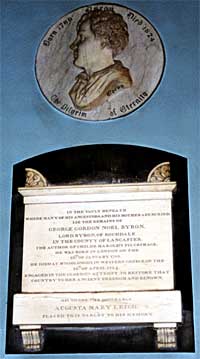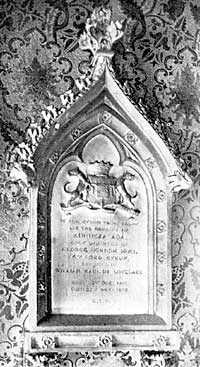
Lord Byron's monument in Hucknall church in 2002.
The church is widely known as the burial place of the poet Byron, whose ancestors succeeded to a large portion of the parish after the dissolution of Newstead Priory, and who became patrons of the living in 1617. The Byron vault received its first occupant in June, 1638. Following is a list of interments there:—
1638. Cicile, wife of Sir John Byron.
1640. Anne, daughter of Sir Richard, afterwards Lord, Byron.
1641. A supposed sister of the above lady.
1645. Mistress Cicile, daughter of Richard Byron, Esquire.
1655 or 6. Gilbert Byron. He was taken prisoner in the fight at Willoughby.
1657. Lady Elizabeth Byron. Her leaden coffin is inscribed:
“Here lyeth the body of Lady Elizth. Byron, 1st wife of Lord Richard Byron.”
1664 to 1675. Five children of the Honble. William Byron, of Bulwell Wood Hall.
1679. Honbie. Wm. Byron.
1679. Richard, 2nd Lord Byron, aged 74. He fought at Edge Hill, and held Newark Castle against the Parliamentary forces. His estates were sequestrated in 1649, but restored in 1660. King Charles gave his widow 1,000 oaks in his forest of Sherwood, and she was awarded a pension of £500 per annum.
1683. Honbie. Mrs. Elizabeth Chaworth Byron. This lady was the donor of the chalice and paten still used in the church.
1695. William, 3rd Lord Byron.
1703. Lady Byron, 1st wife of the 4th Lord. She was daughter of the Earl of Bridgwater, and died of smallpox, April 10th, 1703, aged 27.
1712. Lady Byron.
1719. George Byron.
1724. Francis Byron.
1736. William, 4th Lord Byron. In 1702 he was created Bow-bearer in the Sherwood Forest, and married a daughter of the Duke of Portland.
1798. Fifth Lord Byron. He killed Chaworth in a duel at the Star and Garter Tavern, London, in 1765. His sister married Lord Carlisle, who is referred to in “English Bards and Scotch Reviewers,” aged 75.
1811. Catherine cordon Byron, the poet’s mother.
1824. July 16th. Lord Byron, the poet.
1852. Ada, Lady Lovelace, the poet’s daughter.
 Monument in Hucknall church to Ada Lovelace,
Lord Byron's daughter.
Monument in Hucknall church to Ada Lovelace,
Lord Byron's daughter.The vault is formed of two cells, and the marble tablet set in the chancel floor is immediately over the poet’s coffin. The leaden coffin of the poet’s mother is inscribed:—“ The Hon. Catherine Gordon, mother of George, Lord Byron, and lineal descendant of the Earl of Huntley, and the Lady Jean Stuart, daughter of King James 1st of Scotland, died in the 46th year of her age, August 1. 1811.”
Soon after the poet’s death, a marble tablet was affixed on the chancel wall near the tomb, on which is inscribed
“In the vault beneath, where many of his ancestors & his mother are buried lie the remains of George Gordon Noel Byron, Lord Byron of Rochdale in the county of Lancaster, author of ‘Childe Harold’s Pilgrimage.’ He was born in London on the 22nd January, 1788. He died at Missolonghi in Western Greece, on the 19th April, 1824, engaged in the glorious attempt to restore that country to her ancient freedom and renown. His sister, the Honourable Augusta Mary Leigh, placed this tablet to his memory.” In 1881, the floor tablet, of Rosso antico marble,’ the gift of the King of Greece, was placed over the tomb. Four years ago, Sir Tollemache Sinclair placed a marble medallion portrait (by Adams-Acton) on the chancel wall, and a number of marble tablets in the north-east chapel (now a vestry) containing comments by eminent writers on the poet and his works.
A Hucknall resident makes the following statement:— “My father was at the windmill on the Connery on the burying day of Lord Byron, and he told me often how he watched, from the upper loft of the mill, the long sombre train of carriages and people slowly approach the church from Linby Wighay. The pulpit, reading desk, and windows were draped in black. Byron’s coronet was on the top of his coffin, but before the vault was closed somebody stole one of the five gilt knobs off the coronet. Numbers of people went into the vault, which is an arched structure. I looked in the vault in 1852, when Lady Lovelace was buried, and saw the coronet with its four gilt knobs. The entrance to the vault was about five feet wide, and there were about twelve steps. At the foot of the steps, to the left, stood a large urn, as high as Lord Byron’s coffin, bearing the following inscription:— ‘In this urn is the heart and intestines of Lord George Noel Byron.’ The late William Calladine also went into the vault and copied the inscription on the urn, and challenged a lecturer named Richardson, who asserted that the Greeks kept the heart of Byron. I well remember the old sexton who used to lower a candle into the vault through a hole in the flagstone, in order to show the coffin to curious people.”
